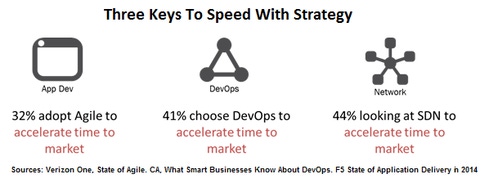As every company that's conquered a market knows, dominance is not just about capturing the crown -- it's about keeping it.

Time to market is imperative in the age of applications -- of that there is no doubt. Second place is the first loser, and getting a viable product out the door before the competition is the most tangible and visible sign that you've won. But being king only means more people trying to knock you off your perch.
I'm not saying slow down. I'm saying move fast in a strategic way.
CIOs get this. "Projects delivered on time" came in at number six among the Top 10 CIO Priorities in The Society for Information Management's 35th IT Trends Study, behind business concerns such as increasing the value of IT to the business, contributing to strategy and customer satisfaction, and innovation.
[Does Apple Pay add to the appeal of the new operating system? Read Apple Pay: Where To Use It.]
That applies to the internal market as well. Efficiency is as critical to CIOs as revenue: "Productivity improvements" came in at number eight on list. So yes, speed -- not of ports and packets, but of process and getting code to production -- is critical.
But keeping that crown once it's atop your head means focusing as much on ongoing delivery of the app as its deployment.

In order to hold and consolidate dominance, you must keep an incredibly fickle consumer base -- both employees and customers -- engaged. Apps plagued by performance, security, or availability issues are an invitation to your competitors to stage an application coup. What a coup looks like for external customers is clear and can be measured in revenue drops. Internally, the intrigue might be more subtle, with CMOs snatching IT dollars and SaaS vendors sidling around IT to engage business leaders.
User experience is key, from the interface to the speed with which the client communicates with back-office or cloud-hosted servers. Fail to encourage adoption (downloads and installations) and engagement (actual use), and you can bet challengers gathered outside the walls will start planning their own coronations. Failing fast might be better than failing in agonizing slow motion, but it's still failure.
Work smart
Productivity today is sometimes improved by introducing a new application, but first, see if you can simply remove constraints on existing apps. Like what? Two things.
First and foremost is the constraint that ties apps to a specific platform. Consider this quote from a McKinsey & Company survey: "When we recently surveyed 250 CIOs on their mobility strategies, 56 percent reported strong demand from employees to support a wide range of mobile devices." With no direct mention of applications, you might think CIOs are reporting that employees need be allowed to use their own devices. But dig deeper into this and similar surveys and you'll find that what CIOs and employees mean by "support a wide range of mobile devices" is really "make applications available on all the devices we might want to use."
Really, if it were just about being able to carry their own devices at work, there wouldn't be near this level of angst around BYOD, would there? Of course not.
Mobility is about apps, and about providing for employees (and customers) a way to engage with and conduct business through those apps. And, when I say, "Mobility is a driving factor in the Game of Applications," I don't mean just the insatiable consumer demand for engaging mobile apps. Your employees have an increasing appetite for accessing business applications and data through mobile apps.
Second, minimizing constraints around app performance or security absolutely improves productivity. Single sign-on is a prime example. In the healthcare industry, SSO has been shown to save clinicians an average of 9.51 minutes a day (122 hours per year), which translates into an estimated $2,675 per clinician for a total annual savings of more than $2.6 million in a large practice.
Taking the crown in this Game of Applications is easier than keeping it. First, get your app to market, whether internal or external, and then focus on eliminating the constraints that impede adoption, revenue growth, and productivity. Even if the snow-topped hill you stand atop is in Wisconsin, not Westeros, take the long view on what it takes to not only win the game, but reap its rewards for many years to come.
The Internet of Things demands reliable connectivity, but standards remain up in the air. Here's how to kick your IoT strategy into high gear. Get the new IoT Goes Mobile issue of InformationWeek Tech Digest today. (Free registration required.)
About the Author(s)
You May Also Like







